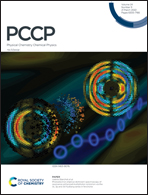Fundamental studies of vibrational resonance phenomena by multivalued resummation of the divergent Rayleigh–Schrödinger perturbation theory series: deciphering polyad structures of three H216O isotopologues
Abstract
A fundamental quantitative study of the vibrational resonances of three H216O H,D-isotopologues with a quartic Watson Hamiltonian was carried out using the resummation of the high-order (∼λn, n ≤ 203) divergent Rayleigh–Schrödinger perturbation theory (RSPT) series by quartic Padé–Hermite multivalued diagonal approximants PH[m,m,m,m,m], m ≤ 40. The resonance condition between a pair of states is formulated as the existence of a common complex energy solution branch point inside the unit circle: |E(λj)|, Re(λj)2 + Im(λj)2 ≤ 1. For the matrix formulation of the vibrational problem (VCI), the existence of common branch points is governed by the Katz theorem and they can be found as roots of discriminant polynomials. The main branches of the Padé–Hermite approximants typically reproduce VCI energies with high accuracy while alternative branches often fit nearby resonant states. The resummation of the RSPT series for H2O and D2O (up to the tenth polyad) revealed not only Fermi and Darling–Dennison resonances, but also unusual (0,2,−5) and (5,−2,0) resonance effects matching the (5,2,5) polyad structure, while the (3,2,1) structure was rigorously confirmed for HDO. It is demonstrated that the (5,2,5) polyad structure ensures good organization of high-energy resonating states and breaks down the classic (2,1,2) structure. The advocated methodology of quantitative description of resonance phenomena and revealing polyad structures is suitable for larger molecules and can be adapted to linear molecules and symmetric tops. Its application ensures rigorous classification of vibrational states and can be used in quantitative vibration–rotation spectroscopy.



 Please wait while we load your content...
Please wait while we load your content...